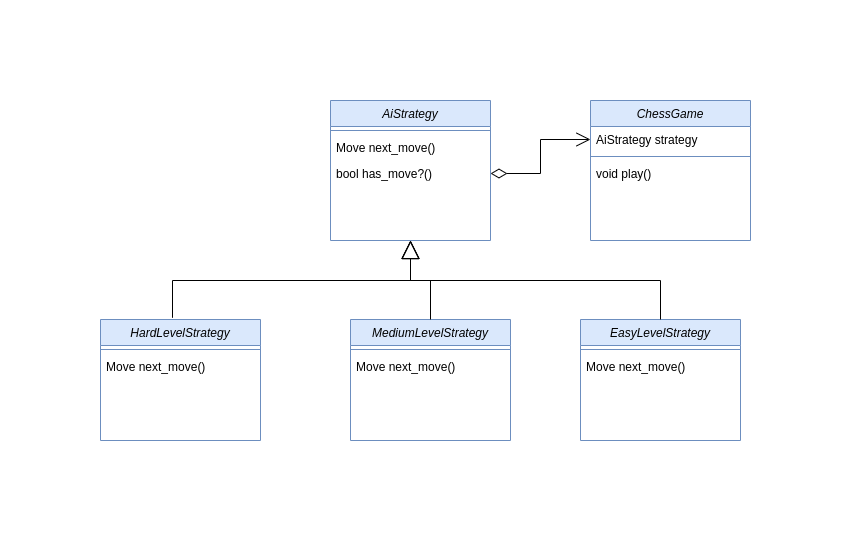Strategy pattern is a behavioral pattern which is used when there is a need to choose an algorithm on runtime. It’s a very good example of open/closed principle.
What is Open/Closed Principle
Software entities (classes, modules, functions, etc.) should be open for extension, but closed for modification.
The idea is to add new functionality without changging the existing classes. So how does Strategy Pattern makes sure open/closed principle is used in our code, lets find out.
Understanding Strategy Pattern with an example
Lets say we’re building an AI player for a chess game, we have to define 3 levels for the game - easy, medium and hard. Based on the level the player chooses we need to adjust the difficulty of the AI player.
This means there are 3 algoritms(or strategies) from which the AI player can use to make its next move. We’ll call these strategies. There will be one ChessGame class which will pick from one of these strategies. So we’ll have following classes:
- HardLevelStrategy - Defines the algorithm for hard level.
- MediumLevelStrategy - Defines the algorithm for medium level.
- EasyLevelStrategy - Defines the algorithm for easy level.
- AiStrategy - Abstract class to define methods required to be implemented by each strategy.
- ChessGame - Uses one of the strategy to make the next move for the AI player.

class AiStrategy
def next_move
raise NotImplementedError.new
end
def has_move?
# if ai's king is still present
end
end
class HardLevelStrategy < AiStrategy
def next_move
# Returns next move based on hard level
end
end
class MediumLevelStrategy < AiStrategy
def next_move
# Returns next move based on medium level
end
end
class EasyLevelStrategy < AiStrategy
def next_move
# Returns next move based on easy level
end
end
One of the strategies is picked on runtime based on which level the player chooses. Lets create a ChessGame class to use these strategies:
class ChessGame
def initialize(strategy:)
@strategy = strategy
end
def play(player:)
while true
if player.has_move?
player.wait_for_players_move
else
return "Player #{player.player_name} lost the game"
end
if @strategy.has_move?
@strategy.next_move
else
return "Player #{player.player_name} wins the game"
end
end
end
end
class Player
attr_accessor :player_name
def wait_for_players_move
# wait for player to make the next move
end
end
If the player chooses medium level then we’ll pass MediumLevelStrategy to the ChessGame class to use as the strategy:
strategy = MediumLevelStrategy.new
game = ChessGame.new(strategy: strategy)
game.start(player: Player.new)
The level strategy of the game is set on the runtime. What about open/closed principle ?
To find out if our design follows the open/closed principle we’ll add another level to our game - the random level. To add this new level we’ll need to create a new strategy RandomizedStrategy:
class RandomizedStrategy < AiStrategy
def next_move
# Returns next move based on easy level
end
end
As we did before for MediumLevelStrategy we can use our new strategy in the ChessGame class by passing an isntance into it:
strategy = RandomizedStrategy.new
game = ChessGame.new(strategy: strategy)
game.start(player: Player.new)
So we created a new class RandomizedStrategy and were able to introduce the functionality without doing any modification on our existing classes, which is what the open/closed principle states.
Wrap Up
In general, the strategy pattern contains the following classes:
- AbstractStrategy - An abstract class which defines the methods to be implemented by each strategy.
- StrategyA - A strategy class which implements type A strategy.
- StrategyB - A strategy class which implements type B strategy.
- StrategyC - A strategy class which implements type C strategy.
- Executor - Accepts a strategy on runtime and executes the particular algorithm.

There can N number of strategies as long as it implements the methods defined in AbstractStrategy.